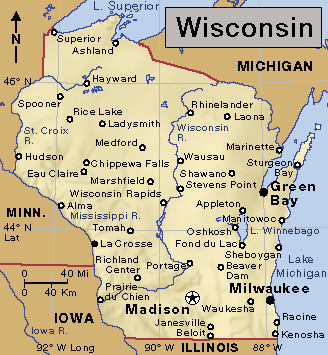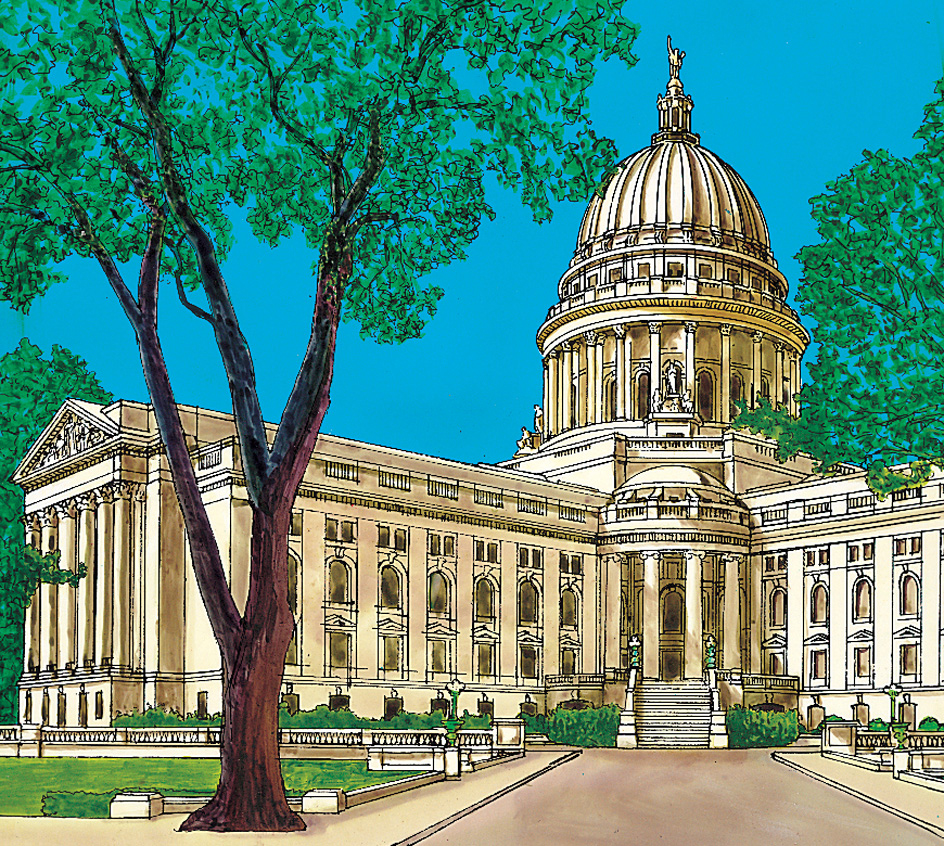Madison (pop. 269,840; met. area pop. 680,796) is the capital and second largest city of Wisconsin. Only Milwaukee has more people. Madison is the home of the largest campus of the University of Wisconsin System. It also is a center of medicine, dairy-based agribusiness, and recreation. Madison is the trade center of a rich agricultural region. It lies in south-central Wisconsin.

Downtown Madison lies between Lakes Mendota and Monona, and Lake Wingra is in the western part of the city. These lakes help make Madison one of the nation’s most beautiful state capitals.
Two land investors, James D. Doty and Stevens T. Mason, founded Madison in 1836. They named it for James Madison, the fourth president of the United States. Doty and Mason chose the site because its lakes provided scenic beauty.
Description.
Madison covers 101 square miles (262 square kilometers), including 21 square miles (54 square kilometers) of inland water. It is the county seat of Dane County. Madison’s metropolitan area consists of Columbia, Dane, Green, and Iowa counties. These counties have a combined area of 3,386 square miles (8,770 square kilometers). The dome of the white granite State Capitol towers 286 feet (87 meters) above the heart of downtown Madison. Federal, state, and municipal government buildings stand nearby. The University of Wisconsin campus lies about 1 mile (1.6 kilometers) west of the Capitol on the south shore of Lake Mendota. The campus and Capitol are connected by State Street, a pedestrian mall with many shops and restaurants.

The University of Wisconsin-Madison is one of the nation’s largest universities. Madison is also the home of Edgewood College and Herzing University. The city serves as a medical center, with the University of Wisconsin medical school and several hospitals and clinics.
Madison’s cultural attractions include the Wisconsin Historical Museum, the Chazen Museum of Art, Monona Terrace Community and Convention Center, and Overture Center for the Arts. Overture Center includes several spaces for visual and performing arts. The block-long center includes Overture Hall, a large performance hall; a renovated Capitol Theater; a small theater called the Playhouse; and the Madison Museum of Contemporary Art. The University of Wisconsin also operates the 1,260-acre (510-hectare) Arboretum in Madison. A zoo is in Henry Vilas Park. Lakes in and near Madison provide boating, fishing, swimming, and water-skiing.

Economy
depends heavily on government operations and on trade. Federal, state, and local government agencies and the University of Wisconsin employ a large percentage of the area’s workers. Many other workers hold jobs in retail and wholesale trade and in such services as health care, finance, insurance, and research. The city has dozens of research and testing laboratories.
The Madison area has hundreds of manufacturing plants. Farming and cattle raising in the area have helped make food processing a major industry in Madison. Other factories produce agricultural equipment, batteries, hospital supplies, and a variety of other products.
Railroad freight lines and bus and trucking companies serve Madison. Airlines use Dane County Regional Airport on Madison’s east side.
Government and history.
Madison has a mayor-council form of government. Voters elect the mayor to a four-year term and the 20-member Common Council to two-year terms.
Winnebago Indians, now formally known as the Ho-Chunk Nation in Wisconsin, lived in what is now the Madison area before white settlers came. In 1835, the site was bought by James D. Doty, a federal judge who later became governor of the Wisconsin Territory, and Stevens T. Mason, the governor of Michigan Territory . In 1836, the first Wisconsin Territory legislature made Madison the capital, even though the community did not yet exist. Its first white settlers, Eben and Rosaline Peck, arrived from nearby Blue Mounds in 1837. They erected a hotel for the workers who built the first Capitol.
Madison began functioning as the capital in 1838 and remained the capital when Wisconsin gained statehood in 1848. Madison was incorporated as a village in 1846 and became a city in 1856.
The Oscar Mayer company opened its meat-packing plant in the city in 1919 and helped make Madison a major food-processing center. During the 1920’s, the city became the headquarters of the Progressive Party, led by the La Follette family of Madison. This party pioneered in social reform legislation.

During the 1960’s, a rapid increase in employment by the federal, state, and municipal governments in Madison created a population boom. Since the early 1970’s, many buildings in downtown Madison have been constructed or extensively renovated. Monona Terrace Community and Convention Center, completed in 1997, was built according to plans by the famous American architect Frank Lloyd Wright.
In 2001, Madison’s city council approved plans for the construction of a downtown arts district. The district, which features Overture Center, was completed in 2006.
